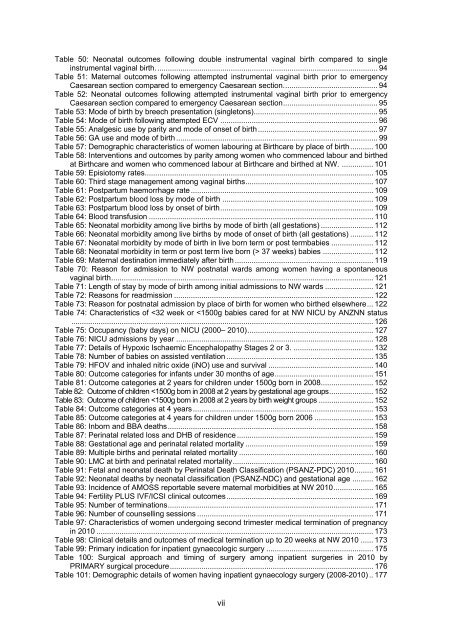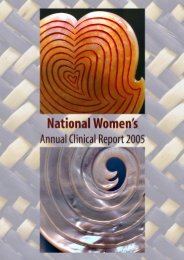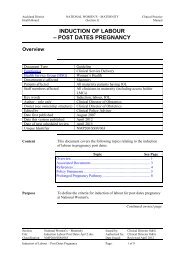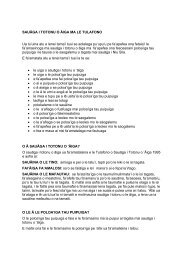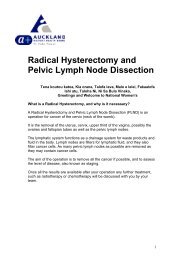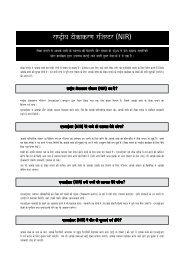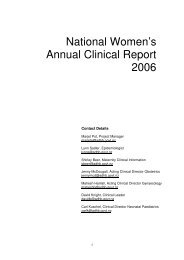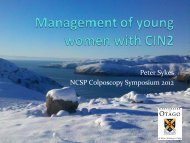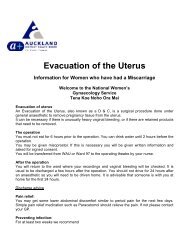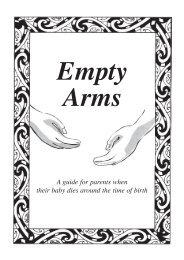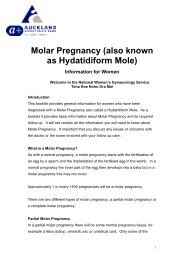National Women's Annual Clinical Report 2010
National Women's Annual Clinical Report 2010
National Women's Annual Clinical Report 2010
Create successful ePaper yourself
Turn your PDF publications into a flip-book with our unique Google optimized e-Paper software.
Table 50: Neonatal outcomes following double instrumental vaginal birth compared to single<br />
instrumental vaginal birth.......................................................................................................... 94<br />
Table 51: Maternal outcomes following attempted instrumental vaginal birth prior to emergency<br />
Caesarean section compared to emergency Caesarean section............................................. 94<br />
Table 52: Neonatal outcomes following attempted instrumental vaginal birth prior to emergency<br />
Caesarean section compared to emergency Caesarean section............................................. 95<br />
Table 53: Mode of birth by breech presentation (singletons)........................................................... 95<br />
Table 54: Mode of birth following attempted ECV ........................................................................... 96<br />
Table 55: Analgesic use by parity and mode of onset of birth ......................................................... 97<br />
Table 56: GA use and mode of birth ................................................................................................ 99<br />
Table 57: Demographic characteristics of women labouring at Birthcare by place of birth........... 100<br />
Table 58: Interventions and outcomes by parity among women who commenced labour and birthed<br />
at Birthcare and women who commenced labour at Birthcare and birthed at NW. ............... 101<br />
Table 59: Episiotomy rates............................................................................................................. 105<br />
Table 60: Third stage management among vaginal births............................................................. 107<br />
Table 61: Postpartum haemorrhage rate ....................................................................................... 109<br />
Table 62: Postpartum blood loss by mode of birth ........................................................................ 109<br />
Table 63: Postpartum blood loss by onset of birth......................................................................... 109<br />
Table 64: Blood transfusion ........................................................................................................... 110<br />
Table 65: Neonatal morbidity among live births by mode of birth (all gestations) ......................... 112<br />
Table 66: Neonatal morbidity among live births by mode of onset of birth (all gestations) ........... 112<br />
Table 67: Neonatal morbidity by mode of birth in live born term or post termbabies .................... 112<br />
Table 68: Neonatal morbidity in term or post term live born (> 37 weeks) babies ........................ 112<br />
Table 69: Maternal destination immediately after birth .................................................................. 119<br />
Table 70: Reason for admission to NW postnatal wards among women having a spontaneous<br />
vaginal birth............................................................................................................................. 121<br />
Table 71: Length of stay by mode of birth among initial admissions to NW wards ....................... 121<br />
Table 72: Reasons for readmission ............................................................................................... 122<br />
Table 73: Reason for postnatal admission by place of birth for women who birthed elsewhere... 122<br />
Table 74: Characteristics of


